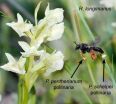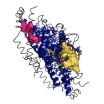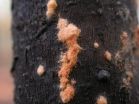(Press-News.org) Scientists have discovered why orchids are one of the most successful groups of flowering plants - it is all down to their relationships with the bees that pollinate them and the fungi that nourish them. The study, published tomorrow in the American Naturalist, is the culmination of a ten-year research project in South Africa involving researchers from Imperial College London, the Royal Botanic Gardens, Kew, and other international institutions.
The orchid family is one of the largest groups of flowering plants, with over 22,000 species worldwide. Today's research suggests that there is such a huge range of species because orchids are highly adaptable and individual species can interact with bees, and other pollinators, in different ways.
For example, when orchids Pterygodium pentherianum and Pterygodium schelpei live side by side, Pterygodium pentherianum puts its pollen on the bee's front legs, whereas Pterygodium schelpei puts it on the bee's abdomen, as in the photo above. This means that one bee can carry pollen from two distinct species without mixing it.
The study also shows how orchids are able to live harmoniously together, with different species working in partnership with different microscopic fungi in the soil, ensuring they do not compete with each other.
Prior to today's study, it was known that orchids have strong interactions with bees, which pollinate the flowers in return for food such as nectar or oils, and also with fungi, which supply minerals to the roots in return for sugars. These relationships are amongst the best examples of nature's system of 'mutual benefit' and are believed to have been important for enabling orchids to evolve into so many different species. However, the mechanisms by which these relationships affect the number of plant species, and these species' ability to coexist, had remained obscure.
Professor Tim Barraclough, from the Division of Biology at Imperial College London, co-led an international team of plant scientists to investigate how these interactions affect orchid diversity. "Orchids are hyper-diverse globally, particularly in South Africa, where they have diversified to a large extent, so we wanted to find out how lots of species are able to exist without competition," he said.
The group studied 52 orchid species in a small region of South Africa, which all secrete oil inside their flowers that female bees collect to feed to their larvae. In order to investigate which pollinating bees were visiting the different species, they collected orchid pollen from the bees for DNA sequencing and analysis. They found strong evidence that when an orchid moved to a new geographical area it adapted to a different pollinating bee species, and interestingly, some competing orchid species were able to adapt by placing pollen on different body parts of the same bee.
"What is remarkable in these orchids is that diversity is generated not only through switches between bees, but also by switches between different body parts of the same bee, so two closely related orchids might place pollen on different segments of one bee's front leg," added Professor Barraclough. "It's given us a fundamental insight into how so many new species can originate, and once they originate how they are able to coexist without exchanging genes."
The researchers also studied the microscopic fungi living on the roots of the orchid, to see how this relationship was affecting plant diversity. Most flowering plants host microscopic fungi in their roots that help the plant take up nutrients from the soil. Until now it has been difficult to investigate this interaction, as most of the fungi belong to species that are difficult to culture. The researchers overcame this challenge by combining a molecular technique known as DNA barcoding with field experiments. In contrast to the bees, where co-occurring orchid species normally share the same insect pollinator, the plants needed to use different fungal partners in order to coexist in the same region.
"By tapping into different kinds of fungi, different plant species access different pools of nutrients and so the problem of living together without competing for the same resources is solved," said Professor Barraclough. However, the same fungal partners are found in different geographical areas and so orchid species that originate in different areas, by adapting to different pollinators, tend still to use the same fungi.
The team's fieldwork shows that shifts in pollination traits were important for bringing about new species and allowing coexistence in a diverse group of orchids, whereas shifts in fungal partner were important for coexistence but not for speciation. Many other groups of flowering plants enter into similar relationships with pollinators and fungi, and both the origins and the future survival of that diversity could depend critically on understanding these relationships.
Dr Richard Waterman, now at the University of Sheffield, who conducted the research as part of his PhD at Imperial College London and the Royal Botanic Gardens, Kew, commented on the next steps for the scientists: "We need a better understanding of these relationships if we are to predict and counter the effects of the worldwide decline in pollinators and soil quality."
INFORMATION:
The research was funded by NERC, NRF South Africa, Stellenbosch University, NSF IGERT and the Royal Botanic Gardens, Kew.
Wealth of orchid varieties is down to busy bees and helpful fungi, says study
2011-02-01
ELSE PRESS RELEASES FROM THIS DATE:
SRNL demonstrating low-energy remediation with patented microbes
2011-02-01
Using funding provided under the American Reinvestment and Recovery Act, the U.S. Department of Energy's Savannah River National Laboratory has launched a demonstration project near one of the Savannah River Site's former production reactor sites to clean up chemically contaminated groundwater, naturally.
A portion of the subsurface at the Site's P Area has become contaminated with chlorinated volatile organic compounds that are essentially like dry-cleaning fluid. SRNL and Clemson University have patented a consortium of microbes that have an appetite for that kind ...
Communication pathways within proteins may yield new drug targets to stop superbugs
2011-02-01
INDIANAPOLIS – A School of Science at Indiana University-Purdue University Indianapolis biophysicist has developed a new method to identify communication pathways connecting distant regions within proteins.
With this tool, Andrew J. Rader, Ph.D., assistant professor of physics, has identified a mechanism for cooperative behavior within an entire molecule, a finding that suggests that in the future it may be possible to design drugs that target anywhere along the length of a molecule's communication pathway rather than only in a single location as they do today. The discovery ...
Wild rainbow trout critical to health of steelhead populations
2011-02-01
CORVALLIS, Ore. – Genetic research is showing that healthy steelhead runs in Pacific Northwest streams can depend heavily on the productivity of their stay-at-home counterparts, rainbow trout.
Steelhead and rainbow trout look different, grow differently, and one heads off to sea while the other never leaves home. But the life histories and reproductive health of wild trout and steelhead are tightly linked and interdependent, more so than has been appreciated, a new Oregon State University study concludes.
The research could raise new challenges for fishery managers ...
Nanosilver: A new name -- well-known effects
2011-02-01
Numerous nanomaterials are currently at the focus of public attention. In particular silver nanoparticles are being investigated in detail, both by scientists as well as by the regulatory authorities. The assumption behind this interest is that they are dealing with a completely new substance. However, Empa researchers Bernd Nowack and Harald Krug, together with Murray Heights of the company HeiQ have shown in a paper recently published in the journal Environmental Science & Technology that nanosilver is by no means the discovery of the 21st century. Silver particles with ...
Morning after pill linked to increase in STIs, study shows
2011-02-01
Offering the morning after pill free over the counter has not reduced the number of teenage pregnancies and may be associated with a rise in sexually-transmitted diseases (STIs), according to a report by experts at The University of Nottingham.
Professors David Paton and Sourafel Girma used local health authority data to study the impact that the introduction of Government-backed schemes to offer emergency birth control at pharmacies and without prescription have had on conception rates and the diagnosis of STIs among under-18s.
Their findings show that, on average, ...
CERN announces LHC to run in 2012
2011-02-01
Geneva, 31 January 2011. CERN today announced that the LHC will run through to the end of 2012 with a short technical stop at the end of 2011. The beam energy for 2011 will be 3.5 TeV. This decision, taken by CERN management following the annual planning workshop held in Chamonix last week and a report delivered today by the laboratory's machine advisory committee, gives the LHC's experiments a good chance of finding new physics in the next two years, before the LHC goes into a long shutdown to prepare for higher energy running starting 2014.
"If LHC continues to improve ...
Red Bull logo enough to shape consumer performance
2011-02-01
Chestnut Hill, Mass. (1/31/2011) – Red Bull's red and gold logo can "give you wings" – for better or worse – even if consumers don't know it, according to a new study by two Boston College professors, who found the brand's edgy marketing efforts have sold a heavy dose of attitude to consumers.
Researchers put subjects at the controls of a car racing video game, supplying each with functionally identical racecars, but each car decorated with a different brand logo and color scheme.
Players put in control of the Red Bull car displayed the characteristics often attributed ...
Specific populations of gut bacteria linked to fatty liver
2011-02-01
The more we learn about biology, the closer we get to being able to treat disease – and the more complicated our understanding of disease itself becomes.
A new research finding showing a strong relationship between complex microbial ecologies in human intestines and the common but serious medical condition known as fatty liver illustrates this paradox.
From past genomic studies, we have learned that a mind-boggling multitude of different kinds of benign bacteria inhabit our intestines and that these populations can vary almost infinitely from one human being to the ...
Free radicals in cornea may contribute to Fuchs dystrophy, most common cause of corneal transplants
2011-02-01
Boston, MA—Scientists have found that free radicals (unstable molecules that cause the death of cells as the body ages) may also cause the damage in the eyes of patients with Fuchs Endothelial Corneal Dystrophy (FECD), a hereditary disease that is one of the most common reasons for corneal transplants worldwide.
The finding, published in the November 2010 American Journal of Pathology, holds promise for early and preventative treatments for this disease, which impacts nearly four percent of the population over age 60.
"Our discovery is significant, because it gives ...
Analysis of bread mold genomes demos 'reverse-ecology' tool
2011-02-01
Berkeley – In a demonstration of "reverse-ecology," biologists at the University of California, Berkeley, have shown that one can determine an organism's adaptive traits by looking first at its genome and checking for variations across a population.
The study, to be published the week of Jan. 31 in the journal Proceedings of the National Academy of Sciences, offers a powerful new tool in evolutionary genetics research, one that could be used to help monitor the effects of climate change and habitat destruction.
The researchers scanned the genes of 48 different strains ...




